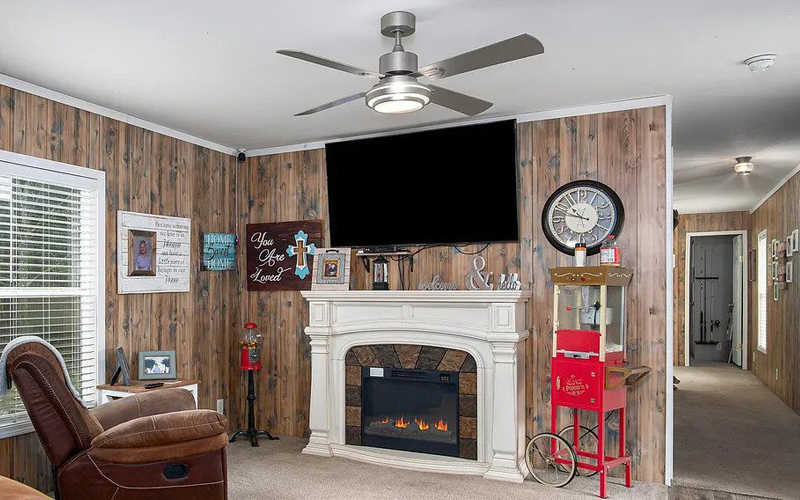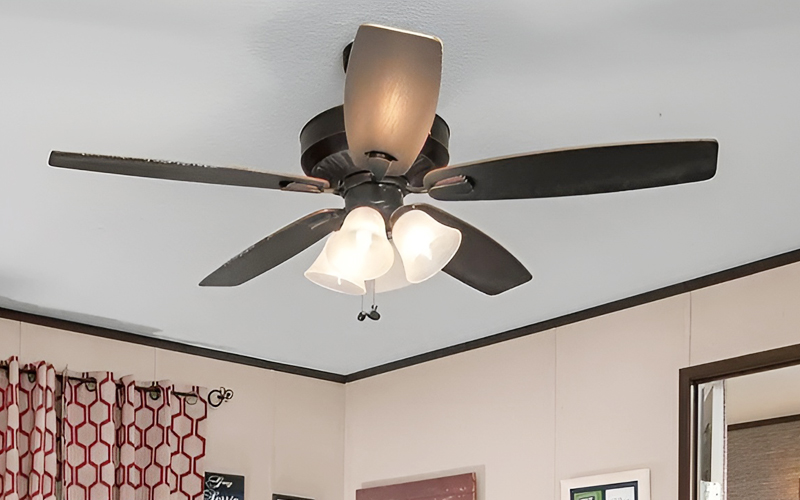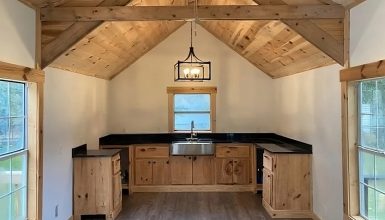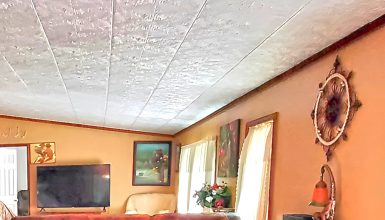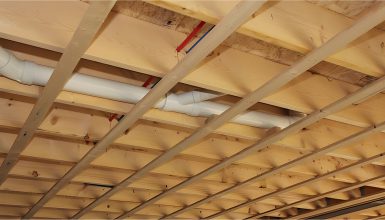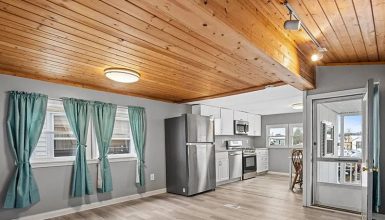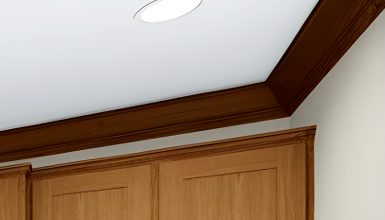A ceiling fan is more than just a functional appliance for mobile homes; it’s a stylish and practical addition to your living space. Also, it can help circulate the air, reduce humidity, and provide a refreshing breeze that makes you feel relaxed and at ease. Plus, they’re an energy-efficient and cost-effective way to beat the heat. So, a ceiling fan is an excellent investment to enhance your mobile home living experience. Let’s explore the ceiling fan options for your mobile home.
Types of Ceiling Fans for a Mobile Home
There are several types of ceiling fans available for mobile homes, including:
1. Low-profile ceiling fans
Low-profile ceiling fans, also known as hugger fans, are a type of ceiling fan that is designed to be installed flush against the ceiling. These fans are ideal for mobile homes with low ceilings, providing maximum headroom and space and adequate air circulation.
2. Standard ceiling fans
Standard ceiling fans are the most common ceiling fan suitable for mobile homes with average ceiling heights. These fans come with downrods; metal rods connect the fan to the ceiling bracket. It allows you to adjust the fans to your desired level.
3. Dual motor ceiling fans
These fans come with two motors, which allows for independent control of each set of blades. This makes them great for larger mobile homes or rooms with high ceilings.
4. Outdoor ceiling fans
These fans are designed for outdoor use, making them an excellent option for mobile homes with outdoor living spaces like porches or patios. They’re built to withstand the elements and come with weather-resistant blades and motor housing.
5. Energy Star-certified ceiling fans
These fans are designed to be highly energy-efficient, helping you save money on your energy bill while reducing your environmental impact. They’re an excellent option for anyone saving money and reducing their carbon footprint.
Ceiling Fan Mounting Options for Mobile Homes
When it comes to installing a ceiling fan in your mobile home, there are several mounting options available to choose from.
- Flush mount
Flush mount ceiling fans, also known as hugger fans, are designed to be installed flush against the ceiling. This mounting option is ideal for mobile homes with low ceilings, providing maximum headroom and space.
- Downrod mount
Downrod mount ceiling fans are designed to be installed using a downrod, the metal rod that connects the fan to the ceiling. This mounting option is ideal for mobile homes with standard ceiling heights. It allows you to adjust the fan’s height to your desired level.
- Angled mount
Angled mount fans are designed to be installed on a sloped or angled ceiling. This mounting option lets you install the fan at the correct angle, providing maximum air circulation and effectiveness.
- Dual mount
Dual-mount ceiling fans are designed to be installed using a downrod or flush mount, providing maximum flexibility and versatility. This mounting option is ideal for those who want to adjust the fan’s height.
How to Choose The Best Mobile Home Ceiling Fan
Regarding selecting a ceiling fan for your mobile home, several factors must be considered, including:
1. Size and height of the room
One of the most important factors to consider when choosing a ceiling fan for your mobile home is the size and height of the room where it will be installed. This is because the fan size needs to be appropriate for the room size to ensure adequate air circulation.
The size of the ceiling fan needed for a mobile home depends on the size of the room where it will be installed. Generally, space up to 75 square feet will require a fan with a blade span of 29-36 inches. While a room between 76-144 square feet will need a fan with a blade span of 36-42 inches. For larger rooms between 144-225 square feet, a fan with a blade span of 44 inches is recommended.
In addition to size, you’ll also want to consider the height of your ceiling. If your mobile home has low ceilings, you’ll need to select a fan with a low-profile or flush mount option to prevent it from being too close to the top. Otherwise, you risk the fan hitting people or objects when it’s in use.
Similarly, if you have high ceilings, you must choose a fan with a downrod long enough to properly position the fan at the right height. Otherwise, the fan won’t be able to circulate air effectively, defeating the purpose of having a ceiling fan in the first place.
2. Blade span and pitch
Another essential factor to consider when choosing a ceiling fan for your mobile home is the blade span and pitch. These factors determine how much air the fan can circulate and how effectively it can cool your space.
The blade span refers to the fan blades’ length, generally ranging from 29 to 54 inches for most residential fans. A larger blade span means the fan can move more air, providing better circulation in larger rooms. However, you’ll also want to ensure that the blade span is appropriate for the size of your room. A fan with a too-large blade span in a small space might be too powerful. While a fan with too small of a blade span in a larger room might not be compelling enough.
The pitch of the fan blades is another crucial consideration. The pitch refers to the angle at which the blades are set, generally ranging from 8 to 15 degrees. A steeper pitch can move more air and provide better circulation. Still, it can also make the fan louder and more challenging. On the other hand, a flatter pitch can be quieter but may not be as effective at circulating air.
3. Motor size and quality
The motor size and quality are also important when choosing a ceiling fan for your mobile home. A high-quality motor will run smoothly and efficiently, providing a quiet and effective fan.
The size of the motor is also essential, as it determines how much power the fan can produce. A larger engine generally means the fan can move more air and provide better circulation. However, it may be noisier and consume more energy.
In addition to size, the quality of the motor is also an important consideration. A high-quality engine will be well-built and durable, allowing your ceiling fan to last longer and function better. Additionally, a high-quality motor will generally be quieter and consume less energy, helping you save money on your energy bill over time.
4. Energy efficiency
A more energy-efficient fan can help you save money on your energy bill and reduce your carbon footprint.
One way to determine the energy efficiency of a fan is to look for the Energy Star label. This label indicates that the fan has been tested and certified to meet strict energy efficiency guidelines set by the Environmental Protection Agency (EPA). Fans with the Energy Star label use 60% less energy than non-certified fans. Making them an excellent choice for those who want to save money and reduce their environmental impact.
Another way to determine the energy efficiency of a fan is to look at the fan’s motor and wattage rating. A fan with a more efficient motor will use less energy while providing adequate air circulation.
Choosing an adjustable speed control fan can also help you save energy. You can set the fan to a lower speed when you don’t need as much cooling power.
5. Noise level
The noise level of a ceiling fan is an important consideration, especially if you plan to use the fan in a bedroom or other quiet space. A loud fan can be distracting and make it difficult to sleep or concentrate.
When selecting a ceiling fan for your mobile home, look for one with a low decibel rating. This indicates that the fan operates quietly without making too much noise. Also, choose a fan with a well-built motor designed for quiet operation.
Another way to reduce noise levels is to select a fan with multiple speed settings. This lets you adjust the fan speed to match your preferences and the room’s noise level. You can set the fan to a lower rate when you don’t need as much cooling power, which can reduce the noise level.
6. Style and design
Ceiling fans come in various styles and designs, from traditional to modern and everything in between. Some fans feature decorative blades or unique shapes, while others have a sleek and minimalist design. When selecting a fan, consider your mobile home’s overall style and layout, and choose a fan that complements it well.
You’ll also want to consider the color and finish of the fan. Many fans come in various colors and finishes, from brushed nickel to bronze and black. Choose a color that matches your home’s other fixtures and finishes to create a cohesive and stylish look.
Another important consideration when it comes to style and design is the lighting. Many ceiling fans have built-in light fixtures, providing lighting and cooling power in one convenient package. Consider the lighting that will work best in your space, whether a warm and cozy ambiance or a bright and functional light.
How To Hang A Ceiling Fan In A Mobile Home
Hanging a ceiling fan in a mobile home requires basic electrical skills and knowledge.
Preparation
First, it’s crucial to ensure that your mobile home’s electrical system can handle the additional load of a ceiling fan.
Most mobile homes have a 120-volt electrical system suitable for most ceiling fans. However, suppose you’re installing a larger or more powerful fan. In that case, you may need to upgrade your electrical system to a 200-volt one to accommodate the increased power needs.
When wiring your ceiling fan, following the manufacturer’s instructions is essential. The wiring process typically involves connecting the wires from the ceiling to the cables provided by the ceiling fan using wire nuts.
Tools
Here is a list of tools you may need when hanging a ceiling fan in your mobile home:
- Screwdrivers: You will need a flathead and a Phillips screwdriver to install the ceiling fan.
- Pliers: Pliers can help twist wire nuts and straighten bent wires.
- Wire cutters: Wire cutters can trim wires to the appropriate length.
- Voltage tester: A voltage tester checks for electrical current in the cables.
- Drill: When installing the mounting bracket, you may need a drill to make holes for the screws and anchors.
- Level: A level can be used to ensure that the mounting bracket is installed straight.
- Ladder: A ladder is necessary to reach and install the ceiling fan.
- Safety glasses: Safety glasses can help protect your eyes from debris and dust.
- Gloves: Gloves can help protect your hands while handling wires and metal parts.
- Circuit tester: A circuit tester can be used to confirm that the power is off before starting the installation process.
Step-by-step to put ceiling fans in a mobile home
Here’s a step-by-step guide on how to install a ceiling fan in your mobile home:
Step 1: Choose the location
Select a location where you want to hang the ceiling fan. Ensure there’s enough clearance and the electrical wiring is easily accessible.
Step 2: Turn off the power
Turn off the power supply to the room where you want to install the ceiling fan. You can turn off the circuit breaker or remove the fuse.
Step 3: Install the mounting bracket
Install the mounting bracket provided with the ceiling fan onto the ceiling using screws and anchors. Make sure the bracket is level.
Step 4: Connect the wires
Connect the electrical wires from the ceiling to the cables provided with the ceiling fan using wire nuts. Match the black wire to black wire, white wire to white wire, and green wire to green wire.
Step 5: Attach the motor
Attach the ceiling fan’s motor housing to the mounting bracket using the screws provided. Make sure the motor housing is securely attached to the bracket.
Step 6: Install the fan blades
Attach the fan blades to the motor housing using the screws provided. Make sure the blades are properly balanced to prevent wobbling.
Step 7: Attach the light kit (if applicable)
If your ceiling fan has a light kit, attach it to the bottom of the motor housing using the screws provided.
Step 8: Turn on the power
Turn on the power supply to the room and test the ceiling fan to ensure it’s working correctly.
Ceiling Fan Cleaning and Maintenance Tips

Regular cleaning and maintenance are crucial for keeping your ceiling fan in good working order and prolonging its lifespan. Here are some tips for cleaning and maintaining your ceiling fan:
- Dust the blades regularly
Use a soft cloth or a dusting brush to remove dust and debris from the blades. You can also use a vacuum cleaner with a soft brush attachment to remove dust from the blades.
- Clean the motor housing.
Use a soft cloth or a brush to clean the motor housing and remove dust or debris. You can also use a mild cleaning solution, such as water and dish soap, to clean the housing. Just make sure to dry the housing thoroughly afterward.
- Balance the fan
An unbalanced ceiling fan can cause excessive noise and damage to the motor. To balance the fan, use a balancing kit (purchased at most hardware stores) and follow the manufacturer’s instructions carefully.
- Tighten screws and bolts.
Over time, the screws and bolts that hold the fan blades and motor housing in place can become loose. Use a screwdriver or a wrench to tighten any loose screws or bolts.
- Lubricate the motor
Most ceiling fans require regular lubrication to keep the motor running smoothly. Check the manufacturer’s instructions for recommendations on how often to lubricate the engine and what type of lubricant to use.
Conclusion
Congratulations, you’ve learned everything you need to know about choosing, installing, and maintaining a ceiling fan in your mobile home! By considering factors such as size, blade span, motor size, energy efficiency, style, and noise level, you can choose the perfect fan to keep you cool and comfortable.


